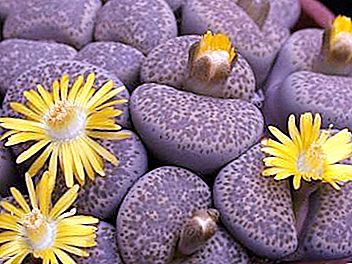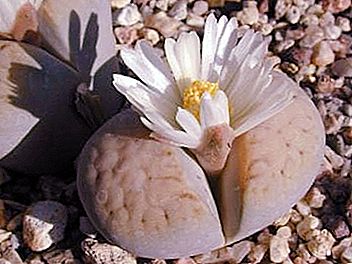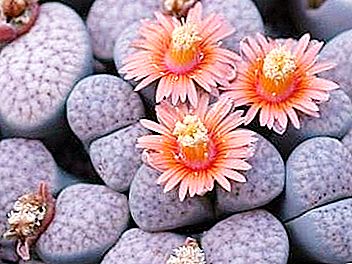Once an English botanist, Burchell, traveling around Africa, made a halt next to a pebble placer. Imagine his surprise when, after looking closely, he realized that these are plants that repeat the shape of the stones surrounding them. So in 1811, "living stones" were discovered - the flowers of lithops turbiniformis. Now more than 60 species and subspecies of these amazing plants are already known. And they are becoming more and more popular among amateur gardeners.
What “living stones” look like - flowers

Imagine the similarity of these unique inhabitants of the arid regions of our planet with fragments of rocks, pebbles and stones is so great that sometimes even natural scientists do not immediately recognize them! Why, people, animals that feed on lithops, can not always find these "mimicry champions."
Outwardly, these are two thick fused leaves, between which there remains a more or less deep gap. It is in it that after a while a white, yellow or pink flower appears, similar to a camomile. It opens in the afternoon and closes in the evening. The size of the flower may exceed the leaves.
Water can destroy the living stone

This flower lives in extremely arid regions of South Africa, where the level of annual rainfall is only 200 mm, so your pets can not tolerate water on the leaves. And you need to water them very carefully, preferably in a pan, draining excess water after a couple of hours so as not to cause rotting of the roots. And only in the spring, summer and autumn (to November), making sure that the soil between the irrigations is thoroughly dry. In winter, lithops are left without water! The signal that it is time to start gentle watering again will be the appearance of new leaves.
" Living stones" - flowers that love the sun (but not scorching), fresh air and are not afraid of drafts. They can decorate the balcony, but take care of the plants from the rain!
Choose a pot and soil
After buying a "pebble" you need to transplant. The lithops have a rod-shaped root that goes deep into the soil. But putting them in a deep pot is not necessary at all. These amazing plants feel good in low (but not very small), wide, preferably ceramic (for better evaporation of excess moisture), pots.
At the bottom lay drainage in the form of broken brick or expanded clay. And the land for planting is mixed with sand and clay. The best substrate for lithops transplantation is considered a mixture of clay-turf and sheet soil, coarse sand and broken brick in the ratio: 1/1/2/1.
Transfer

Since “ living stones” are flowers that do not like loneliness, it is better to plant them in groups, dusting the space between them with small pebbles and pebbles.
You can’t water the flowers before transplanting, as the wounds on the roots applied during planting will heal better. The roots of the lithops must be liberated from the earth very carefully, piercing with an earthen toothpick so that it loosens and crumbles from the root itself. So that the root neck does not rot, they do not bury it in the ground, but lay it around with stones.
Soon, the "flower-stone" - a living and very unusual inhabitant of your apartment - will become a favorite for the whole family, surprising with its beauty and ability to mimic.




